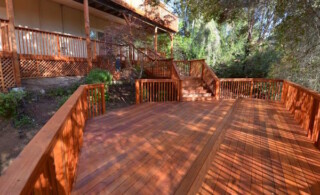On This Page:
What Is Composite Decking?
Composite decking is a combination of sawdust and some kind of plastic. Manufacturers may use polyvinyl chloride (PVC), polyethylene or polypropylene. There are a few different types, including:
- Wood Composite: About 50/50 plastic and wood flour
- Capped Wood Composite: Has a hard outer shell
- PVC: Made entirely from PVC, sometimes called vinyl
- Capped Polymer: All-plastic decking with a protective outer layer
PVC vs. Composite Decking
While composite decking combines sawdust and a variety of possible plastics, PVC boards use just one product. The two may look very similar. A few manufacturers, such as TimberTech, offer both types.
Wood Decking Materials
Most homeowners choose to install a deck made of wood. Popular types include:
- Cedar
- Redwood
- Pressure-treated pine
- Ipe, a Brazilian hardwood
Cedar Composite Decking
Cedar composite decking features the look of cedar. It is not an actual wood product. Many manufacturers make options to mimic other popular styles, such as redwood or ipe.
Compare Quotes from Deck BuildersComposite versus Wood Decking
| Composite | Wood | |
| Cost Per Square Foot | $4-$13 | $10-$25+ |
| Installation Price | $9-$12 | $9-$12 |
| Appearance & Style | Consistent | Noticeable color variation |
| Strength & Durability | High | Variable |
| Maintenance | Low | Moderate |
| Lifespan | 15-25 years | 10-30 years |
| ROI | 70% | 75% |
Composite Decking vs. Wood Cost
- Composite Decking: $4-$13 per square foot for the boards. Remains consistent year-round.
- Wood: $10-$25+. Can vary depending on seasonal availability.
The labor price to install a composite or wood deck ranges from $9 to $12 per square foot. Since the process is quite similar regardless of the material, the cost runs about the same.
Appearance & Style
Composite
Consistent appearance. This means that you’ll get a deck that looks just like the sample.
Wood
May vary significantly in the color and openness of the grain. If you want a lot of character in the boards, prepare to pay more.
Deck Board Strength & Durability
Composite boards are much less likely to scratch or crack. As a man-made material, its strength is somewhere between that of softwoods, like cedar or redwood, and hard ones like Ipe. Wood’s durability depends highly on the species.
DIY Installation
Many composite boards are built for easy cutting and quick installation. This makes it generally simpler for homeowners to DIY, compared to wood.
Maintenance
Composite decking
Requires very little maintenance. Periodically, you may need to pay the cost of deck repair for either material, which averages $800 to $2,600.
Wood
Hire a pro for the following services:
- Price to reseal a deck: $600-$1,300
- Expense to refinish a deck: $800-$1,600
- Deck staining costs: $600-$1,100
Length of Life
Decking materials have a variable lifespan depending on the quality of the product:
- Composite: Cheaper or thinner boards may only last 10-15 years, compared to 25 years for high-end ones.
- Wood: Pressure-treated lumber lasts 10-15 years on average, while Ipe can last for 30 years or more.
ROI or Resale
Both have a relatively high return on investment:
- Composite: 70%
- Wood: 75%
Composite vs. Wood – Individual Types
| Type | Pros | Cons |
| Trex/Composite | Durable, affordable | Can look artificial |
| Ipe Hardwood | Strong, beautiful | Most expensive material |
| Redwood | Excellent color variation | Requires careful maintenance |
| Cedar | Classic appearance | Scratches easily |
| Pressure-Treated Lumber | Can be installed anywhere | Cheaper boards can warp |
| PVC | Highly sustainable | Shorter lifespan |
Trex vs. Wood
Trex
- Low-maintenance
- Consistent coloring makes it easy to know what to expect
- Less likely to fade over time
Wood
- Features a natural look
- Needs resealing and re-staining every 2 to 3 years
- Variable strength and durability
Ipe Decking vs. Trex Composite
Ipe
- Resistant to scratches and rotting
- Average lifespan is 30 years, but could last much longer
- Has a high-end appearance
- Costs more than other materials
- Requires drilling prior to placement, so it’s harder to DIY
Trex Composite
- Costs much less
- Lots of color options
- Mold-and-mildew-resistant
- Shorter lifespan
Trex vs. Redwood
Trex
- Uniform appearance
- Little or no upkeep
- Can last longer
- May not look as natural
Redwood
- Striking color variability
- Will fade without regular resealing
- May scratch or crack
Cedar vs. Composite Deck
Cedar
- Classic deck look
- Relatively easy to re-stain
- Requires regular upkeep
- Won’t last as long if installed near the ground
Composite
- Installs anywhere
- Easy to clean and maintain
- Limited ability to change color without replacing
Composite vs. Pressure-Treated Lumber
Composite
- Lightweight
- Less expensive
- Fades in direct sunlight
Pressure-Treated
- Looks more natural
- Costs more
- Much heavier when wet
PVC vs. Wood
PVC
- Can be 100% recycled material
- Usually costs less
- Looks just like the sample
- Cannot be re-stained
- More prone to warping
Wood
- Can last longer
- Color is hard to predict
- Requires more maintenance
- Less sustainable
 Understanding Deck Construction
Understanding Deck Construction  Cleaning Your Exteriors With a Pressure Washer
Cleaning Your Exteriors With a Pressure Washer  Deck Maintenance Tips
Deck Maintenance Tips  Should You Build a Deck or Hire a Pro?
Should You Build a Deck or Hire a Pro?  3 Benefits of Under-Deck Stain
3 Benefits of Under-Deck Stain 

Are You Familiar With This Topic? Share Your Experience.